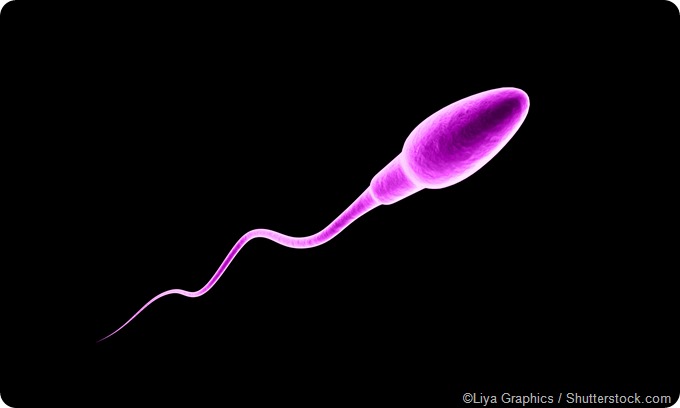Oligospermia is a condition in which the sperm count is below 15 million/ml semen. Many reproductive and non-reproductive causes have been reported, but the cause remains unexplained in most cases. It is the cause of infertility in approximately a third of couples seeking assisted reproductive techniques in order to conceive.

Etiology
Some common etiologies include:
Testosterone absence or insensitivity
- low androgen levels as in hypogonadism (congenital or acquired): Secondary testicular failure, whether congenital or acquired, may result from low gonadotropin secretion with reduced testosterone production.
- Congenital hypogonadotropic hypogonadism (CHH): This form is characterized by a deficiency in the production of gonadotropin (LH, FSH) by the hypothalamus or anterior pituitary. This form is most commonly caused by a development disorder called Kallmann Syndrome, which manifests with a range of phenotypic abnormalities.
- primary testicular failure, with small, soft testes and a high FSH level
- genetic disorders such as Klinefelter’s syndrome
Obstructive disorders
- testicular trauma causing obstruction
- obstruction in the testicular spermatic ducts following damage, disease, inflammation, or congenital causes
- previous testicular surgery
Testicular toxicity
- transient oligozoospermia which often comes on following a major illness, with the count returning to normal within three to six months
- undescended testes in infancy
- post-inflammatory testicular dysfunction: chronic infections or inflammation of the testes or genital tract lead to increased concentrations of reactive oxygen species which can damage the sperm cell membrane, resulting in impaired fertilization.
- some drugs such as testosterone, anabolic steroids, chemotherapy, and certain antibiotics or antidepressants can reduce the sperm count when used over a long duration, but this effect is usually reversible within a year once the medication is stopped
- radiation damage can also result in oligospermia
- in utero exposures to estrogenic compounds, such as diethylstilbestrol, have been associated with abnormal testicular development and oligospermia in adults
- lifestyle or environmental factors including:
- sexually transmitted infections caused by chlamydia, gonorrhea or prostatitis – these result in accessory gland infection and lead to epididymitis, prostatitis (typically subclinical), and obstruction of the testicular ducts
- increased local temperature of the testes due to, for instance, unduly tight innerwear
- alcohol or drug abuse (especially cocaine or marijuana)
- smoking
Genetic causes
Men with severe oligozoospermia, when the sperm count is less than 5 million per ml semen, present with a higher risk (7-10 percent) of genetic abnormalities. These may result in structural or functional testicular abnormalities. Only 20-30 percent of men with azoospermia or severe oligospermia are finally diagnosed to have a specific disorder, while the vast majority of gene abnormalities leading to male infertility remain unknown as of date.
Identified genetic causes of male subfertility include:
- Klinefelter’s syndrome (47 XXY) – this is characterized by testicular atrophy and impaired testosterone production, with azoospermia. Leydig cells are reduced, germ cell lines are atretic, and signs of masculinization are deficient, such as body hair, muscle development, bone density, and breast enlargement, often with learning difficulties and social dysfunction
- Y chromosome microdeletion (YCMD) - this is common in primary testicular or incomplete testicular failure. It involves three azoospermic factor (AZF) regions which are essential for normal spermatogenesis. They are detected in 5-10 percent of men with severe oligospermia. Many of these make testicular sperm retrieval impossible, but others may be bypassed with intracytoplasmic sperm injection (ICSI).
- Congenital hypogonadotropic hypogonadism (CHH) – this is due to deficiency of gonadotropin secretion in the pituitary and is present from birth. It is mostly due to Kallman syndrome, occurring in 1 in 10 000 men. It is caused by aberrant migration of olfactory and GnRH (gonadotropin-releasing hormone)-producing neurons from the pituitary, resulting in anosmia and hypogonadism. However, a range of clinical manifestations has been described including isolated CHH, and more than a few genetic abnormalities have been reported as well. CHH can also occur as a result of other autosomal mutations (FGFR1 or FGF8, for instance) without anosmia.
- cystic fibrosis transmembrane conductance regulator (CFTR) gene mutation, which manifests with congenital absence of the vasa and seminal vesicle atresia, resulting in a low semen volume. More than 1700 mutations have been reported with a corresponding diverse spectrum of clinical disorders, ranging from isolated absence of the vas to classical cystic fibrosis. In the latter, both vasa deferentia are absent in over 95 percent of males.
- abnormalities of various genes which regulate testicular maturation, such as MLH1 or MSH2 gene mutations
- Karyotype abnormalities can show structural anomalies, mostly Robertsonian translocations and inversions of whole chromosomes, which is found in 6 percent of infertile males. Such alterations are found to be eight times more frequent in infertile men than in the control group of fertile men.
- 46,XX karyotype is a rare translocation found in azoospermia, with absence of most of the Y chromosome rendering sperm production impossible.
- X-chromosome linked mutations such as androgen receptor Xq11.2-12 mutation may result in androgen insensitivity and azoospermia
- With increasing number of X chromosomes, the sperm count decreases leading to male subfertility
It is important to genetically test in men with severe congenital idiopathic structural abnormalities or severe oligospermia. This is because many of these cases may be due to paternally transmitted mutations, or be associated with a high risk of miscarriage or fetal abnormality.
Male Infertility: Semen Analysis, Azoospermia, Sperm Mapping, Varicoceles Explained
References
- https://www.ncbi.nlm.nih.gov/pmc/articles/PMC4708302/
- https://www.ncbi.nlm.nih.gov/pmc/articles/PMC196399/
- https://www.ncbi.nlm.nih.gov/pmc/articles/PMC196399/
Further Reading